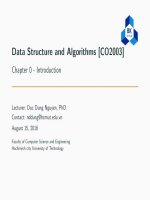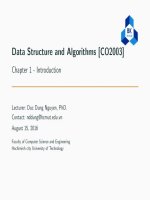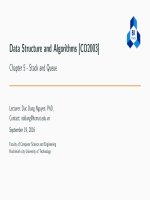C++ programming program design including data structure 7th ch18
Bạn đang xem bản rút gọn của tài liệu. Xem và tải ngay bản đầy đủ của tài liệu tại đây (1.44 MB, 70 trang )
Chapter 18:
Searching and Sorting Algorithms
Objectives
In this chapter, you will:
•
•
•
•
Learn about the various search algorithms
Explore how to implement the sequential search algorithm and how it performs
Explore how to implement the binary search algorithm and how it performs
Learn about the asymptotic notation, Big-O, used in algorithm analysis
C++ Programming: Program Design Including Data Structures, Seventh Edition
2
Objectives (cont’d.)
•
•
•
•
•
Become familiar with the lower bound on comparison-based search algorithms
Learn about the various sorting algorithms
Explore how to implement the bubble sort algorithm and how it performs
Become familiar with the performance of the selection sort algorithm
Explore how to implement the insertion sort algorithm and how it performs
C++ Programming: Program Design Including Data Structures, Seventh Edition
3
Objectives (cont’d.)
•
•
•
Become familiar with the lower bound on comparison-based sorting algorithms
Explore how to implement the quick sort algorithm and how it performs
Explore how to implement the merge sort algorithm and how it performs
C++ Programming: Program Design Including Data Structures, Seventh Edition
4
Introduction
•
Using a search algorithm, you can:
–
–
Determine whether a particular item is in a list
If the data is specially organized (for example, sorted), find the location in the list where a new item
can be inserted
–
Find the location of an item to be deleted
C++ Programming: Program Design Including Data Structures, Seventh Edition
5
Searching and Sorting Algorithms
•
Data can be organized with the help of an array or a linked list
–
–
unorderedLinkedList
unorderedArrayListType
C++ Programming: Program Design Including Data Structures, Seventh Edition
6
Search Algorithms
•
Key of the item
–
•
Special member that uniquely identifies the item in the data set
Key comparison: comparing the key of the search item with the key of an item in the list
–
Can count the number of key comparisons
C++ Programming: Program Design Including Data Structures, Seventh Edition
7
Sequential Search
•
Sequential search (linear search):
–
–
•
Same for both array-based and linked lists
Starts at first element and examines each element until a match is found
Our implementation uses an iterative approach
–
Can also be implemented with recursion
C++ Programming: Program Design Including Data Structures, Seventh Edition
8
Sequential Search Analysis
•
Statements before and after the loop are executed only once
–
•
Statements in the while loop repeated several times
–
•
Require very little computer time
Execution of the other statements in loop is directly related to outcome of key comparison
Speed of a computer does not affect the number of key comparisons required
C++ Programming: Program Design Including Data Structures, Seventh Edition
9
Sequential Search Analysis (cont’d.)
•
•
•
L: a list of length n
If search item (target) is not in the list: n comparisons
If the search item is in the list:
–
–
–
As first element of L 1 comparison (best case)
As last element of L n comparisons (worst case)
Average number of comparisons:
C++ Programming: Program Design Including Data Structures, Seventh Edition
10
Binary Search
•
•
Binary search can be applied to sorted lists
Uses the “divide and conquer” technique
–
–
Compare search item to middle element
If search item is less than middle element, restrict the search to the lower half of the list
•
Otherwise restrict the search to the upper half of the list
C++ Programming: Program Design Including Data Structures, Seventh Edition
11
Binary Search (cont’d.)
C++ Programming: Program Design Including Data Structures, Seventh Edition
12
Binary Search (cont’d.)
•
Search for value of 75:
C++ Programming: Program Design Including Data Structures, Seventh Edition
13
Performance of Binary Search
•
•
Every iteration cuts size of the search list in half
If list L has 1024 = 2
–
•
items
At most 11 iterations needed to find x
Every iteration makes two key comparisons
–
–
•
10
In this case, at most 22 key comparisons
Max # of comparisons = 2log2n+2
Sequential search required 512 key comparisons (average) to find if x is in L
C++ Programming: Program Design Including Data Structures, Seventh Edition
14
Binary Search Algorithm and the class
orderedArrayListType
•
To use binary search algorithm in class orderedArrayListType:
– Add binSearch function
C++ Programming: Program Design Including Data Structures, Seventh Edition
15
Asymptotic Notation:
Big-O Notation
•
•
After an algorithm is designed, it should be analyzed
May be various ways to design a particular algorithm
–
–
Certain algorithms take very little computer time to execute
Others take a considerable amount of time
C++ Programming: Program Design Including Data Structures, Seventh Edition
16
Asymptotic Notation:
Big-O Notation (cont’d.)
C++ Programming: Program Design Including Data Structures, Seventh Edition
17
Asymptotic Notation:
Big-O Notation (cont’d.)
C++ Programming: Program Design Including Data Structures, Seventh Edition
18
Asymptotic Notation:
Big-O Notation (cont’d.)
C++ Programming: Program Design Including Data Structures, Seventh Edition
19
Asymptotic Notation:
Big-O Notation (cont’d.)
•
•
•
•
Let f be a function of n
Asymptotic: the study of the function f as n becomes larger and larger without bound
Let f and g be real-valued, non-negative functions
f(n) is Big-O of g(n), written f(n)=O(g(n)) if there are constants c and n0 such that
f(n)≤cg(n) for all n ≥n0
C++ Programming: Program Design Including Data Structures, Seventh Edition
20
Asymptotic Notation:
Big-O Notation (cont’d.)
C++ Programming: Program Design Including Data Structures, Seventh Edition
21
Asymptotic Notation:
Big-O Notation (cont’d.)
C++ Programming: Program Design Including Data Structures, Seventh Edition
22
Asymptotic Notation:
Big-O Notation (cont’d.)
•
We can use Big-O notation to compare sequential and binary search algorithms:
C++ Programming: Program Design Including Data Structures, Seventh Edition
23
Lower Bound on Comparison-Based Search Algorithms
•
Comparison-based search algorithms:
–
Search a list by comparing the target element with list elements
C++ Programming: Program Design Including Data Structures, Seventh Edition
24
Sorting Algorithms
•
To compare the performance of commonly used sorting algorithms
–
•
Must provide some analysis of these algorithms
These sorting algorithms can be applied to either array-based lists or linked lists
C++ Programming: Program Design Including Data Structures, Seventh Edition
25









